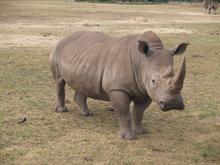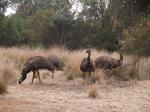 Want to work in Wildlife Conservation?
Want to work in Wildlife Conservation?
Your journey starts here!
- Gain practical skills necessary for conservation of wildlife.
- Increase your employability.
- Gain confidence in your ability and understanding of wildlife management and conservation topics.
- Learn practical flora and fauna (including marine) survey techniques.
- Understand the guiding principles of wildlife ecology, threatened species management, habitat fragmentation and degradation, surveying for endangered species and species recovery.
This course complements our Wildlife Management course.
COURSE STRUCTURE AND CONTENT
There are 10 lessons in this course:
-
Introduction to Wildlife Conservation
-
What is wildlife conservation
-
The need for wildlife conservation
-
Important concepts ecology, ecosystem, biome, conservation values,
biological diversity, genetic drift, habitat, life span, wildlife
movement and wildlife management.
-
Threatening processes habitat fragmentation, habitat degradation and
loss, soil degradation, erosion, pollution, unsustainable harvesting,
invasive species, climate change, population isolation and disease.
-
Biodiversity indicators
-
Terminology
-
Recovery of Threatened Species
-
Loss of species categories of risk
-
Species vulnerability to endangerment
-
Recovery of species and threat management
-
Habitat Conservation identifying critical habitat and protecting habitat
-
Research population growth, habitat use and conservation genetics
-
Captive breeding
-
Translocation
-
Public involvement
-
Habitat Conservation
-
Habitat
-
Types of Habitat eg. temperate and tropical forests, woodland, tundra and mangrove habitats
-
Habitat Use
-
Species Richness
-
Habitat Fragmentation
-
Creating Habitats
-
Restoration Ecology creating habitat corridors, situating corridors, types of corridors, edge effects
-
Habitat Rehabilitation implementing a land management program, determining objectives, determining a program
-
The Role of GIS in Conservation
-
The Role of Protected Areas levels of protection, approaches to reserve selection and limitation of reserves.
-
Approaches to Conservation of Threatened Wildlife
-
Species Approach modelling demography, effective population size, small populations, population viability analysis (PVA)
-
Landscape Approach elements of landscape ecology, distribution of populations within a landscape, landscape modelling
-
Ecosystem Approach the need for ecosystem management, understanding
dynamics, adaptive management, objectives for ecologically sustainable
forest management.
-
Vegetation Surveys
-
Plant Identification common names, scientific names, levels of division, botanical keys,
-
Vegetation survey techniques such as quadrant surveys, landscape assessments, line surveys.
-
Vegetation Mapping remote sensing data.
-
Fauna Surveys
-
Observation techniques spotlighting, scat surveys, census techniques
-
Trapping Techniques radio tracking, call recordings, pit fall traps, Elliot traps.
-
Species identification
-
Marine Surveys
-
Reef Surveys
-
Habitat Surveys
-
Aerial Surveys
-
Over-exploitation
-
Commercial Fish Stock Management
-
Planning for Wildlife
-
Farm Planning
-
Urban Planning
-
Use of GIS
-
Management
-
Managing Threatened Wildlife Populations manipulating populations,
revegetation/restoration, creating corridors, pest control plans,
fencing for species, fire breaks.
-
Wildlife Conservation Project
Each lesson culminates in an assignment which is submitted to the
school, marked by the school's tutors and returned to you with any
relevant suggestions, comments, and if necessary, extra reading.
 Aims
Aims
-
Determine the principles and approaches used towards species recovery.
-
Discuss the principles of habitat conservation with regards to fragmentation, restoration and the use of protected areas.
-
Describe and discuss the various approaches used to conserve threatened species and ecosystems.
-
Appreciate the range of flora survey techniques that have been developed to sample fauna for the purposes of conservation.
-
Discuss and differentiate between fauna survey techniques that have been
developed to sample fauna for the purposes of conservation.
-
Discuss and differentiate between marine survey techniques used to conserve wildlife.
-
Discuss and differentiate the range of planning tools available for
farming, urban and residential planning to help conserve wildlife.
-
Identify various management techniques used to conserve wildlife.
-
Develop a wildlife recovery plan for a species under threat.
 Understanding wildlife populations
Understanding wildlife populations
Determining the current population of a species is an essential starting point for environmental and conservation considerations.
There are many methods used for sampling wildlife populations. The method chosen will depend on the information the wildlife manager wishes to collect. They may wish to conduct counts of populations within a particular region, record the presence of species within a study area or gather population information on a specific species among others. Below are some of the most common methods used.
Aerial Surveys
Aerial surveys are usually undertaken by wildlife managers to assist with improving management techniques of wildlife populations, to gather large amounts of data on different aspects such as habitat, wildlife and ecosystems. It is the most popular survey technique for estimating the size of populations of larger animals. Think of trying to conduct a population survey of deer over a huge area of countryside. Flying over the top of the animals to count them is an effective survey method in this instance and also allows managers to gather other population information such as density, age and sex ratios.
When doing aerial survey work, managers need to first set out the boundaries of the survey area. The plane can then be flown up and down the survey area, and these runs become the transects of the survey.
It is a difficult task to estimate herd numbers, or even to spot some species from the air and takes keen observational skills and a lot of practice to become an expert aerial surveyor.
Trapping
There are various types of traps used by wildlife managers and researchers. These will vary depending on the species you are trapping, the information you wish to collect and the habitat you are working in. Some different types of traps include:
- Elliot style folding traps – these are commonly used for capturing small terrestrial mammals such as rats, mice,
- Mist net traps – these are generally used for capturing bats and birds. There are various designs ranging in size of gauges of mesh and type of material. The choice of mist net will depend on the target species.
- Cage traps – there are a wide range of cage traps used for various species from small mammals, water birds, rabbits, foxes and larger animals such as feral pigs.
- Pit fall traps – these are usually used in conjunction with drift nets to direct small terrestrial animals such as reptiles into pits in the ground.
- Two-stage roost trap – first compartment captures bird which will then walk up to the second compartment to house the birds for up to 2 days. This style of trap is used to capture pest bird species.
There are also traps which kill the captured species. Obviously, live trapping is preferable with desirable populations. When trapping problem species, killing during trapping is an option. However, the actual removal of these individuals from the population does effect the survey data. Ideally, where possible, pest species should be trapped live and removed for disposal.
Transects
Transects are used in both plant and animal surveys. They vary, but as a general rule, transects are straight lines that an observer moves along, or along which traps are placed. The positioning of a transect can effect the data collected. It is best to survey across the grain of a country than along it, such as surveying across a river or over a slope. This will provide more information on the variation in habitats and species within a study area.
When undertaking transect surveys, tally counters move along the transect recording the animals seen or heard. This type of counting requires skilled observers, as animals maybe difficult to see, identify (think of some bird species for example) or easily frightened.
Indirect Methods
Indirect methods are those methods used to calculate the size of a population when the animal itself isn’t actually counted or is counted but does not depend on accurate animal counts. It may be based on observing their activity such as burrowings or excreted faeces.
Another example of a method in where animals are not counted is where some small mammals can be counted by putting out PVC pipes that have a sticky inside. The fur of the mammals gets caught and stuck to the sticky lining, but the animal moves on. Managers can identify the animals by fur analysis and thus get an indirect picture of the population. The presence of animals can also be noted by observing burrows, nests, footprints, and scats or using call-back recordings to survey birds. The use of call-back recordings is especially useful for locating birds of prey such as owls that are difficult to locate visually.
Examples of methods where animals are counted but accuracy is not needed include the change of ratio method, the mark-recapture method and incomplete counts.
Mark-recapture
Mark recapture methods are just as the name suggest – a sample of the animal population are caught, tagged and released. There are a number of different ways of carrying out mark recapture surveys. These include the Peterson model, frequency of capture models, estimation of density, many counts and two counts.
Data collected from mark-recapture surveys can be used to estimate the size of a population and identify trends in population growth or decline.
Roadside or Call Counts
This type of survey is often used with birds. Usually, volunteers are asked to fill out forms detailing sitings or calls of a particular species in a particular area. Information is then collated and analysed. Researchers can use Call Counts to estimate population sizes, identify bird species within a specific study area or use over time to observe the population trends of a particular species.
Why Study with ACS?
Design your own learning pathway.
Study at your own pace, from anywhere, at any time.
Receive prompt, expert support from our team of committed and friendly tutors.
Your learning is our priority. We are flexible and adaptable to meet your educational needs!
Enrolling is easy - just go to the top of this page and select your study method and payment option.
If you have any questions about studying with ACS, or want to know more about any of our courses, get in touch with our specialist tutors today. They will be happy to answer your questions and look at different study options to fit in with your goals.